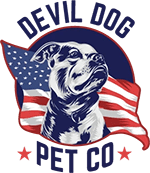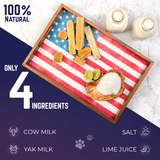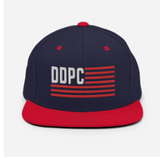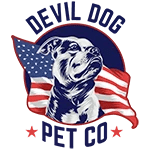Key Takeaways
- Choosing the right chew for small dogs requires consideration of jaw strength, bite width, and chewing duration.
- Small Himalayan dog chews provide a digestible and long-lasting option when properly sized for little dogs.
- Incorrectly sized chews can pose choking hazards and lead to emergency situations.
- Matching chew size to your dog's specific needs ensures both safety and dental health benefits.
Table of Contents
- Start Here: What "Small Himalayan Dog Chews for Little Dogs" Really Means
- How Himalayan Yak Chews Are Made, and Why That Matters for Tiny Teeth
- Sizing for Small Dogs: Exact Measurements, Weight Bands, and Jaw Strength
- Safety First for Little Dogs: Hardness, Choking, and Session Protocols
- Nutritional Profile for Small Breeds: Protein, Lactose, and Calories
- Longevity for Small Chewers: What to Expect and How to Stretch It
- How to Introduce Himalayan Chews to Puppies and Small Adults (Step-by-Step)
- The Puff Trick: Safely Using the Small End Piece for Tiny Dogs
- Comparison Guide for Small Dogs: Himalayan Chews vs. Alternatives
- Reading Labels Like a Pro: Ingredients, Origin, and Hardness Levels
- Storage, Shelf Life, and Freshness for Apartment Living and Travel
Small Himalayan Dog Chews for Little Dogs: The Complete, No-Nonsense Guide
Finding the right chew for your 4-15 pound dog isn't about downsizing human treats, it's about matching jaw strength, bite width, and session tolerance to prevent choking while delivering dental benefits. Small Himalayan dog chews for little dogs offer a digestible, long-lasting solution when sized correctly, but the wrong dimensions can turn enrichment into an emergency room visit.
These cheese-based chews pack serious staying power compared to bully sticks, yet remain gentler on tiny teeth than antlers. The key lies in understanding exact sizing protocols, hardness management, and session timing that keeps your toy breed safe while satisfying their chew drive.
For owners seeking the best fit, Small - Himalayan Dog Chew - 4 Pack is specifically designed for little dogs, while those with multiple small breeds can explore the full range of Small Himalayan Dog Chews to match each dog's needs.
Start Here: What "Small Himalayan Dog Chews for Little Dogs" Really Means
Small Himalayan dog chews for little dogs are compressed yak and cow milk bars specifically dimensioned for 4-15 pound breeds. Unlike generic "small" labels, proper sizing targets 3.5-5.5 inches in length with 0.6-1.1 inch thickness, weighing 25-60 grams depending on your dog's jaw strength and bite style.
Small Chew Specs at a Glance
- 4-7 lb dogs: 3.5-4.25" long, 0.6-0.8" thick, 25-35g
- 8-10 lb dogs: 4-4.75" long, 0.75-1.0" thick, 35-50g
- 11-15 lb dogs: 4.75-5.5" long, 0.9-1.1" thick, 50-60g
- First sessions: 10-15 minutes, then 15-20 minutes max
The composition, yak milk, cow milk, salt, and lime juice, creates a lactose-free final product (typically <0.1% lactose) through traditional pressing and drying. This process removes whey while concentrating protein and minerals into a digestible matrix that won't splinter like rawhide.
Safety rules for tiny jaws: the chew must be longer than your dog's muzzle and cannot fit between back molars. Start with 10-15 minute supervised sessions, retiring the bar when it shrinks to 1.5 times your dog's bite width.
How Himalayan Yak Chews Are Made, and Why That Matters for Tiny Teeth

Traditional Himalayan processing creates the ideal hardness profile for small breeds through a six-step method that concentrates milk proteins while removing moisture that could cause spoilage or inconsistent texture.
- Curdling: Fresh yak and cow milk mixed with lime juice separates curds from whey
- Pressing: Curds compressed under weight for 24-48 hours, removing excess moisture
- Shaping: Dense blocks cut into bars and rounded for safe handling
- Smoking: Light wood smoke adds flavor and begins surface hardening
- Sun-drying: 3-4 weeks of controlled drying reduces moisture to <10%
- Grading: Final inspection for uniform density and smooth edges
This 4-week drying timeline creates the dense, non-splintering texture that makes small Himalayan dog chews for little dogs safer than quick-processed alternatives. Properly dried bars maintain consistent hardness throughout, preventing the soft spots that can break off as choking hazards.
Sizing for Small Dogs: Exact Measurements, Weight Bands, and Jaw Strength
Proper sizing prevents choking while maximizing chew time through three key measurements: your dog's weight, muzzle length, and bite style. Measure from nose tip to the point where the muzzle meets the skull, your chew must exceed this length by at least 0.5 inches.
| Dog Weight | Chew Dimensions | Bar Weight | Session Time | Expected Longevity |
|---|---|---|---|---|
| 4-7 lbs (Nibblers) | 3.5-4.25" × 0.6-0.8" | 25-35g | 10-15 min | 45-90 total minutes |
| 8-10 lbs (Moderate) | 4-4.75" × 0.75-1.0" | 35-50g | 15-20 min | 30-60 total minutes |
| 11-15 lbs (Strong Jaws) | 4.75-5.5" × 0.9-1.1" | 50-60g | 15-20 min | 25-45 total minutes |
Bite style matters as much as weight. Gentle nibblers who lick and scrape can handle the lower end of their weight range, while dogs who crunch straight down need thicker bars and closer supervision. The chew should never fit entirely behind your dog's back molars, this creates swallowing risk.
For multi-dog households, size up to the largest dog's requirements or supervise separately. A 6-pound Yorkie and 12-pound Cavalier need different dimensions, even though both qualify as "small breed."
Safety First for Little Dogs: Hardness, Choking, and Session Protocols
Hard chew management for toy breeds requires proactive supervision and session structure to prevent dental damage and choking incidents. Unlike larger dogs who can power through mistakes, small breeds need precise protocols from day one.
Supervision
Small Dog Chew Supervision Checklist
- Pre-session: Inspect chew for cracks, measure against muzzle length
- During: Stay within arm's reach, redirect straight-down biting to side gnawing
- End trigger: When nub reaches 1.5x bite width or session timer hits 20 minutes
- Post-session: Rinse chew, air-dry before storage
Initial hardness can overwhelm tiny mouths, so pre-soak the tip in warm water for 2-3 minutes to slightly soften the surface. Towel-dry for better grip, then present while your dog is calm, never during high arousal or food excitement.
Session timing prevents overuse injuries common in enthusiastic small chewers. Week one: 10-15 minutes maximum with 48-hour breaks between sessions. Week two onward: 15-20 minutes, 3-4 times weekly. Remove immediately if you hear tooth-on-chew clicking sounds, this indicates excessive force that risks dental damage.
Nutritional Profile for Small Breeds: Protein, Lactose, and Calories

Small Himalayan dog chews for little dogs deliver concentrated nutrition through high protein (65-75%), minimal fat (4-6%), and virtually zero lactose after the 4-week drying process removes whey. This macro profile supports muscle maintenance in active toy breeds without the digestive upset common with dairy-sensitive dogs.
Calorie density averages 3.5 kcal per gram, making a 30-gram small bar approximately 105 calories spread across multiple sessions. For an 8-pound dog requiring ~280 calories daily, this represents roughly 37% of daily needs, but since consumption spans 4-6 sessions over 2 weeks, actual daily calorie impact stays within the 10% treat guideline.
Digestibility surpasses rawhide significantly. While rawhide passes through largely unchanged, yak cheese breaks down completely in stomach acid like regular food protein. Introduce gradually with 10-minute sessions, monitoring stool consistency for 24-48 hours. Loose stools indicate too much too fast, reduce session length and frequency until tolerance builds. For more on safe treat digestibility, see safe chews for dogs.
Avoid yak chews if your small dog has pancreatitis history or severe dairy allergies. The concentrated protein and residual milk components can trigger flare-ups in sensitive individuals, despite the low lactose content.
Longevity for Small Chewers: What to Expect and How to Stretch It
Realistic chew-time varies dramatically by jaw strength and chewing style. Light nibblers (6-9 pounds) typically extract 45-90 total minutes across 3-5 sessions per bar, while moderate chewers (10-15 pounds) finish the same bar in 30-60 total minutes over 2-4 sessions.
Total Time per Bar: Benchmarks
- Gentle nibblers: 60-90 minutes total (5-6 sessions)
- Moderate chewers: 35-60 minutes total (3-4 sessions)
- Power chewers: 20-35 minutes total (2-3 sessions)
Extension tactics maximize value without compromising safety. Freeze the chew for 20 minutes pre-session to increase hardness and slow consumption. Rotate between two bars, offer Bar A for 15 minutes, store it, then offer Bar B the next session. This prevents moisture buildup that softens the surface.
Storage method impacts longevity significantly. Keep chews in open air between sessions rather than sealed containers, which trap moisture and accelerate softening. A properly stored bar maintains consistent hardness for months, while poorly stored chews can become too soft within days.
How to Introduce Himalayan Chews to Puppies and Small Adults (Step-by-Step)
First-week onboarding for 8-12 week puppies requires gentler protocols than adult small dogs due to developing jaw muscles and teething sensitivity. Adult small dogs can typically handle standard introduction timelines with minor supervision adjustments.
- Days 1-3: 8-10 minute sessions with hand-holding the first 2 minutes to encourage side-gnawing rather than straight-down biting
- Days 4-7: 10-15 minute sessions on a designated place mat with light tethering to prevent excited pacing
- Week 2 onward: 15-20 minute sessions with standard supervision protocols
Use a place mat or designated chew area from session one to establish location boundaries. Tether your small dog's leash to prevent zoom-chewing, the excited running-while-chewing behavior that increases choking risk in toy breeds.
Practice trade drills during every session to prevent resource guarding. Say "Trade," present a higher-value treat within one second, take the chew with your other hand once they release. Repeat this 2-3 times per session until the exchange becomes automatic.
The Puff Trick: Safely Using the Small End Piece for Tiny Dogs

The final nub poses choking risk for toy breeds, but proper puffing transforms it into a safe, crunchy treat. This technique prevents waste while eliminating swallowing hazards through controlled expansion that creates a light, digestible snack.
- Soak: Submerge nub in water for exactly 5 minutes
- Microwave: 45-90 seconds until expanded 2-3 times original size, watch continuously and stop if scorching occurs
- Cool: Minimum 10 minutes air cooling, or 2-3 minutes in freezer for faster service
- Serve: Break into bite-sized pieces for toy breeds
The resulting texture resembles a cheese puff, crunchy outside, airy inside, completely digestible. Serve under supervision in small pieces to prevent gulping, especially for dogs under 10 pounds. For a ready-to-use option, try Himalayan Dog Chew Nuggets for Making Yak Chew Cheese Puffs that are designed for safe puffing in the microwave.
Comparison Guide for Small Dogs: Himalayan Chews vs. Alternatives
Choosing the right chew for toy breeds requires balancing safety, longevity, and dental benefits. Small Himalayan dog chews for little dogs occupy the sweet spot between ultra-hard antlers and quick-consumption treats, but understanding alternatives helps match your dog's specific needs.
| Chew Type | Hardness Level | Digestibility | Odor | Longevity | Tooth Safety | Mess Factor |
|---|---|---|---|---|---|---|
| Himalayan Yak | Medium-Hard | Fully Digestible | Minimal | 2-3 weeks | Good with supervision | Light crumbs only |
| Bully Sticks | Medium | Fully Digestible | Moderate-Strong | 3-7 days | Excellent | Minimal |
| Antler (Split) | Very Hard | Minimal | None | 4-8 weeks | Risk for small teeth | Bone dust |
| Rawhide | Variable | Poor | Chemical smell | 1-3 days | Choking risk | Soggy mess |
| Collagen Rolls | Soft-Medium | Good | Light | 1-2 days | Excellent | Minimal |
For gentle nibblers and seniors: Himalayan chews and collagen rolls provide the best balance of safety and engagement. Both digest completely and won't stress sensitive teeth. For more on dental health, see dog dental care from the AVMA.
For power chewers under 15 pounds: Himalayan chews sized up one level offer maximum longevity without the tooth-cracking risk of antlers. Bully sticks work as shorter-duration alternatives. If you want to compare options, 6" Ultra Thick Bully Stick - 3pk is a popular choice for small but determined chewers.
For sensitive stomachs: Start with collagen or lightly baked bully sticks before progressing to yak chews. The dairy protein in Himalayan chews, while minimal, can trigger reactions in extremely sensitive dogs. For a deeper dive into safety, read bully sticks for dogs are they safe.
Reading Labels Like a Pro: Ingredients, Origin, and Hardness Levels
Premium small Himalayan dog chews for little dogs contain exactly three ingredients: milk (yak and/or cow), salt, and lime juice. Any additional components, artificial flavors, colorants, gums, or preservatives, indicate mass-produced alternatives that sacrifice quality for shelf stability.
Pass/Fail Label Test
- ✓ Pass: Milk, salt, lime juice only
- ✓ Pass: "Made in Nepal" or "Traditional Himalayan"
- ✓ Pass: Hardness rating suitable for small breeds
- ✗ Fail: Artificial flavors, colors, or preservatives
- ✗ Fail: "Himalayan-style" without origin country
- ✗ Fail: No size guidance for toy breeds
Country of origin matters significantly. Traditional Nepalese production involves village cooperatives using centuries-old techniques, while "Himalayan-style" often indicates factory production with shortcuts that affect hardness and digestibility.
Visual inspection reveals quality instantly. Uniform density and color indicate proper drying; irregular patches suggest rushed processing. Rounded edges show hand-finishing care essential for small mouths, while sharp corners indicate machine-cutting without safety considerations.
Hardness scales vary by manufacturer, but look for "small-breed friendly" or mid-range ratings for dogs under 15 pounds. Ultra-hard variants designed for large breeds can crack tiny teeth, while overly soft versions dissolve too quickly to provide dental benefits. For more on the pros and cons of antlers, see are antlers for dogs a good idea.
Storage, Shelf Life, and Freshness for Apartment Living and Travel

Proper storage prevents moisture buildup that softens chews and creates mold conditions. Store unused bars in breathable containers, mesh bags, open jars, or paper bags work perfectly. Avoid sealed plastic containers that trap humidity and accelerate deterioration.
Between sessions, rinse the chew under warm water only, no soap or chemicals. Towel-dry thoroughly, then air-dry for 12-24 hours before storing. This removes saliva residue without compromising the structural integrity that keeps chews appropriately hard.
Travel requires extra attention to moisture control. Pack chews in breathable pouches rather than sealed bags, and allow air-drying time at your destination before the next session. Hotel bathrooms and humid climates can soften chews within hours if stored improperly. For a curated selection of options for dogs 5-25 lbs, browse chews for small dogs.
Download the FREE 10-Step Dog Prep Guide
Frequently Asked Questions
How do I determine the correct size of Himalayan dog chew for my small dog based on their weight and jaw strength?
Match chew size to your dog's weight and jaw strength by choosing bars 3.5 to 5.5 inches long and 0.6 to 1.1 inches thick, weighing 25 to 60 grams. Lighter, gentler chewers can handle smaller, thinner bars, while stronger jaws need thicker pieces to prevent quick breakage and choking hazards.
What safety precautions should I take when introducing Himalayan yak chews to puppies and small adult dogs?
Start with short, supervised sessions of 10–15 minutes to monitor chewing style and prevent swallowing large pieces. Always size the chew appropriately, provide fresh water, and watch for any digestive upset. Gradually increase chew time as your dog adapts to the hardness and texture.
How does the traditional Himalayan processing method affect the hardness and digestibility of these chews for little dogs?
The yak and cow milk curds are pressed, smoked, and sun-dried over weeks, creating a dense, hard chew that softens with saliva. This natural process yields a long-lasting, lactose-free treat that breaks down safely in the digestive system, making it gentler on small dogs' teeth than rawhide or antlers.
What are the nutritional benefits of Himalayan dog chews compared to other chew alternatives like bully sticks or antlers?
Himalayan chews offer a balanced source of dairy protein with minimal lactose, providing about 3.5 calories per gram. They are fully digestible and low-odor, unlike antlers which are mineral-rich but indigestible, or bully sticks which are meat-based with higher fat and stronger smell. This makes them a great option for small dogs needing gentle yet nutritious enrichment.






